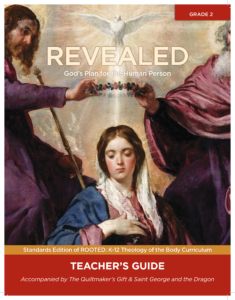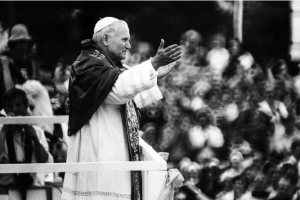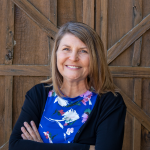
Finding Your Voice with Theology of the Body
June 13, 2022
As the current school year has ended, I reflect on one of the experiences that really stood out to me in the 28 years that I taught in a Catholic elementary school. I was blessed to work with so many students from diverse backgrounds, varying capacities, and specific challenges. It was not until my 26th year teaching that I had the privilege to work with a child who had been diagnosed with selective mutism. That year, “Andrew” was in my class, and he never spoke at school and very rarely talked at home. His parents reassured me that they were happy for him to silently sit in class and share his answers in written form. Although they desperately wanted to help him “find his voice,” they were told by a therapist not to push him, and that he would speak when he had something important to share.

I remember that I was excited to share the new Ruah Woods Theology of the Body curriculum with the children that year as I loved the illustrations in the classic books that are included with and integral to the materials. This was my first year teaching Ruah Woods’ TOB, so I wasn’t sure how it would be received. I recall sitting all 29 second graders in front of me on the carpet as I began to read the story Saint George and the Dragon. I noticed and enjoyed how engaged they all were. The fight between the dragon and Saint George truly captivated their imaginations! When I had finished reading, I asked them to think about how the “Red Cross Knight” (as he is referred to in the book) was like Jesus (this is an example from our Second Grade Teacher’s Guide, Lesson 7: The Dignity of the Human Person). They mentioned how the Knight sacrifices his body to save the people from the dragon, and Jesus gives a total gift-of-self on the cross by willingly offering up his body to save us from sin. This led the whole class into a discussion of the fact that all people are created in God’s image and likeness, and how we should value, appreciate, and protect all lives. The students did a great job telling each other their favorite part and answering the guided learning questions which helped them to discover deep, universal truths about the human person. Meanwhile, Andrew was silent, attentive, and smiling.

That evening around bedtime I received an email from Andrew’s mom. She described that she had happy tears running down her face as she began her correspondence. She continued to describe how Andrew excitedly recounted the entire story as soon as he returned home from school that day. Bursting with this inspiring tale, he next told his little brother all about Saint George and how he was courageous as he protected the lives of the townspeople against the terrible dragon. His mom said this was the most he had ever spoken to them, and that he continued to excitedly share more details all the way up until his bedtime that night! She thanked me for reading this book and was appreciative that such wonderful curriculum was being taught in our school in such a clever, safe way, through story. I asked her if it was ok for me to ask him about it in class the next day. She encouraged me to try, and to let her know his reaction.
The next day my class sat together during religion to continue the important TOB discussion. I mentioned to Andrew that I had heard from his mother that he enjoyed the story and asked if he wanted to share his favorite part with the class. He nodded yes, and then in a hesitant and quiet voice said that his favorite part was when Saint George was fighting the dragon. He said that he thought Saint George was very brave and courageous. The class was stunned. We all looked at him for a few seconds in disbelief. Then I said, “Well I think you are brave to tell us about it!” It was such a wonderful opportunity for my students to see that each one of them brings a unique perspective and their own gift to our school family. This brought us to the part of the lesson where the children are shown images of people in various stages of life (in utero to elderly), and asked questions about each individual’s comparative value and worth. Andrew’s courage to speak led us beautifully into this theme that ALL people including those with differing abilities, ages and stages were created as gifts by God to love him, know him, and serve him and our fellow neighbors. Not only did this event cement my belief in the importance of instilling these Theology of the Body themes early on, but it also inspired me personally to become more deeply passionate and active in the pro-life movement as well. Andrew was empowered that day when he found his voice through the teachings of Theology of the Body. He felt proud of himself and was able to share more verbally in class and at home as the year went on.

A first-grade teacher who I worked with mentioned that she will often use her Ruah Woods’ TOB curriculum when the students seem a little more antsy that day. Whether they are having difficulties with issues at recess, struggling with friendships, or just giving off a sense of “hurriedness” those are the times she finds TOB lessons even more effective and valuable in her classroom. She will ask them to reflect on the story, theme or activity at hand, then quietly direct them to put into words how they felt when a situation occurred in their own life with another student. This stirs compassion and understanding in the children to recognize the dignity and value of every person by listening to another’s perspective. What a great skill to teach children early on as they learn to express themselves and speak respectfully when there is a conflict. Another poignant lesson from this theme is to discuss the protection of all life with the class at an age-appropriate level. As a follow up to this discussion, one of the activities included in the curriculum is to write letters to their mothers thanking them for their protection while they were so vulnerable as a pre-born human person. This is a Mother’s Day gift that really speaks to the heart of each mom!

The book, “The Loving Heart” is a tribute written to celebrate the fact that Pope St. John Paul II (the author of the Theology of the Body) cared deeply for those who were suffering with illness, disability, or marginalized. It describes the prayers and public addresses he gave on behalf of the sick. In one address to a mixed crowd of adults and children in Austria (1988) he spoke from the heart when he told them, “Unfortunately in the world today not everyone realizes that those afflicted with old age, sickness, and handicap have the same value as other human beings. And yet God is not interested in how productive we are or in the size of our bank account. The Lord looks not at appearances, but at the heart. We are all sons and daughters of the same Heavenly Father. It is so important to participate in this gift of his love and share it with others in this life.”
I would encourage all teachers to implement our beautiful K-12 Theology of the Body curriculum to facilitate your students’ discovery of their unique voice, recognition of their authentic identity, and ability to communicate fully with one another while respecting the inherent dignity of themselves and each other.

Written by,
Dena Reany,
Regional Curriculum Consultant (West) for Ruah Woods Institute
dreany@ruahwoods.org
Share